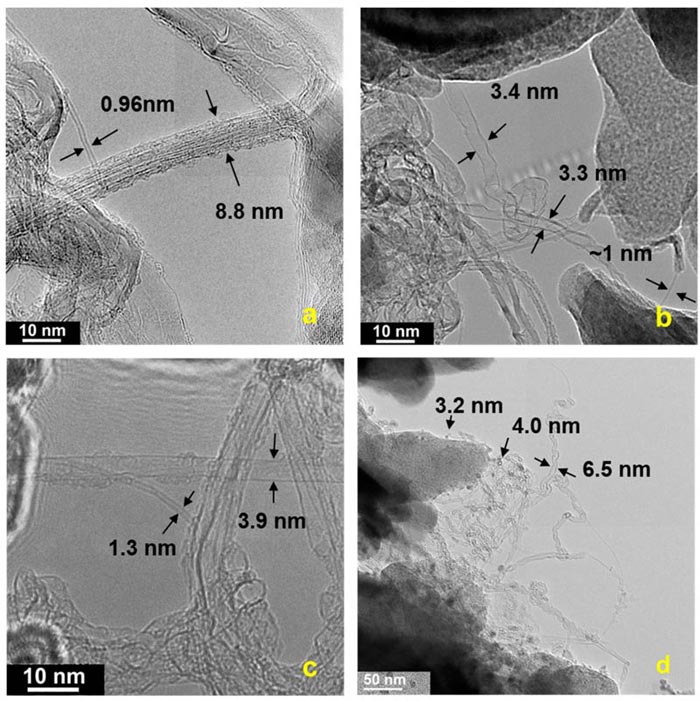Research shows old newspapers can be used to grow carbon nanotubes

TEM images of raw carbon soot grown on kaolin sized paper showing (a) roped single-walled carbon nanotubes (SWCNTs) helically wrapped by a SWCNT, and large SWCNTs, (b) collapsed, (c) folded, and (d) twisted nanotubes. Scale bar = 10 nm (a-c) and 50 nm (d). Credit: Rice University
A research collaboration between Rice University and the Energy Safety Research Institute (ESRI) at Swansea University has found that old newspapers can be used as a low cost, eco-friendly material on which to grow single walled carbon nanotubes on a large scale.
Carbon nanotubes are tiny molecules with incredible physical properties that can be used in a huge range of things, such as conductive films for touchscreen displays, flexible electronics, fabrics that create energy and antennas for 5G networks.
The new study, published in the MDPI Journal C , details the research experiments carried out in producing carbon nanotubes which could have the potential to solve some of the problems associated with their large scale production such as:
- The high cost of preparing a suitable surface for chemical growth.
- The difficulties in scaling up the process, as only single surface growth processes have been previously available.
The research team discovered that the large surface area of newspapers provided an unlikely but ideal way to chemically grow carbon nanotubes.
Lead researcher Bruce Brinson said: “Newspapers have the benefit of being used in a roll-to-roll process in a stacked form making it an ideal candidate as a low-cost stackable 2D surface to grow carbon nanotubes.”
However, not all newspaper is equally good – only newspaper produced with sizing made from kaolin, which is china clay, resulted in carbon nanotube growth.
Co-author Varun Shenoy Gangoli said: “Many substances including talc, calcium carbonate, and titanium dioxide can be used in sizing in papers which act as a filler to help with their levels of absorption and wear. However it was our observation that kaolin sizing, and not calcium carbonate sizing, showed us how the growth catalyst, which in our case was iron, is affected by the chemical nature of the substrate.”
ESRI Director Andrew Barron, also a professor at Rice University in the USA, said: “While there have been previous research that shows that graphene, carbon nanotubes and carbon dots can be been synthesised on a variety of materials, such as food waste, vegetation waste, animal, bird or insect waste and chemically grown on natural materials, to date, this research has been limited.
“With our new research, we have found a continuous flow system that dramatically reduces the cost of both substrate and post synthesis process which could impact on the future mass manufacture of single walled carbon nanotubes.”
Media Contact
All latest news from the category: Information Technology
Here you can find a summary of innovations in the fields of information and data processing and up-to-date developments on IT equipment and hardware.
This area covers topics such as IT services, IT architectures, IT management and telecommunications.
Newest articles

Durable, Efficient, Sustainable: The Rise of Cerium Oxide Thermal Switches
Groundbreaking cerium oxide-based thermal switches achieve remarkable performance, transforming heat flow control with sustainable and efficient technology. Cerium Oxide-Based Thermal Switches Revolutionize Heat Flow Control Thermal switches, which electrically control…

How Industrial Robots are Reducing Emissions in Global Manufacturing
A new study explores the intersection of industrial automation and environmental sustainability, focusing on the role of industrial robots in reducing the carbon intensity of manufacturing exports. The research demonstrates…

Patients Can Heal Through Precise, Personalized Bioceramic Grafts
A recent review is transforming the landscape of craniomaxillofacial bone regeneration with the introduction of personalized bioceramic grafts. This pioneering research explores the fabrication and clinical potential of synthetic grafts…



